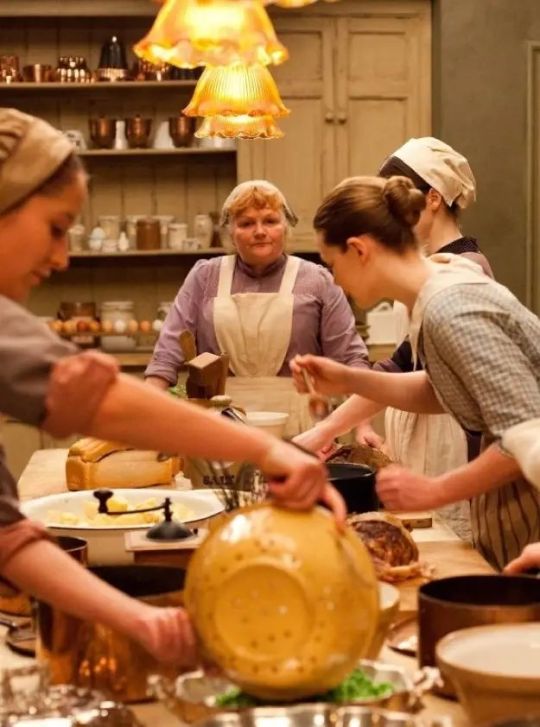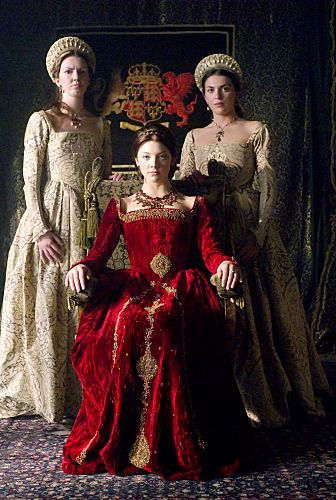There is a little black hole somewhere out there that all of my motivation gets sucked into.
Don't wanna be here? Send us removal request.
Text
Fantasy Guide to Royal Households and How they Work

When I say Households, I mean the entourage that follows around the royal family. The household went everywhere with them to care for their needs from the people who would empty their chamber pots to their noble companions. Most royal households are basically the same as noble ones, only on grander scale. Every royal had a household and an entourage as well as every noble at court.
Palace Personnel ~ The Commons

The commons were an intregal part of every household. They made up perhaps 80% of the work force. Royal courts were often on the road and never spent more than a few months at every palace. The court was constantly moving. Some positions were not permanent, meaning certain servants did not travel with the court because they were employed at the palace only. They would be paid by the Monarch's paymaster.
Scullion: The scullion was a relatively easy position to fill so they were often changed as the court went from palace to palace. They would be responsible for scrubbing and cleaning the servants quarters and the kitchens. They would scrub floors with lye, scour pots with sand, sweep put the fireplace and clean up after the other servants. They were the first to rise in a castle and tasked to light all the fires in the kitchens. Scullions would just be employed to the palace and serve a multitude of chambers
Laundress: The laundress was responsible for the cleaning of anything made of fabric in the household. Since they are handling unmentionables, they knew what happened behind closed bedchamber doors. They knew when the King visited the Queen or hadn't, they knew when marriages were consummated or not and they knew when the Queen and royal women were not pregnant. They often sold secrets to pad their pockets. Laundresses might be permanent staff but sometimes not.
Minstrels: The minstrel was a commoner hired to play an instrument or sing for the entertainment of the royal. A royal might staff a few at a time but they would always have one on hand. The minstrel would likely come with their masters as they travelled. The minstrel might serve the main royal household but a royal might retain their own.
Cook: The cook was one of the most important servants in the household. They would have the task of overseeing the running of the kitchens and keeping supplies in order. They would likely be on call at all times. Henry VIII's cook was often woken in the night because his royal master wanted a midnight snack. The cook was a valued member of the household and would have been highly sought after if they were a very skilled cook. They would have travelled with the joint. Cooks were apart of the greater royal household but often royals retained private cooks for their own use.
Maidservant: The maidservant cleans the castle. She would sweep the floors, scrub them, empty the chamberpots, get rid of the ashes from the fire and ready the fire for later. She would make up the bed or strip it for the laundresses. She would wash anything that needed washing including furniture and ornaments. She was likely not a travelling servant and would be strictly employed at a single palace.
Jester: The jester was the hired entertainer. Working under the master of revels, the jester had the daunting task of making the monarch and their family laugh. They would tell jokes, tell stories, cause havoc in the court for laughs and lighten the mood. The most successful jester of all time was Will Somers, jester to Henry VIII. Will broke bad news to the infamously bad tempered monarch and got away with things that would have sent others to the block. Will survived most of Henry's reign, his head intact. Jesters would be apart of the main household though each royal might have one of their own.
Positions within the Royal Household ~ Noble


Nobility were always welcomed at court. They eat at court, slept at court and were cared for by the monarch. Some nobles had to sing for their supper and most were hired as royal servants. They weren't exactly scrubbing floors and would be paid handsomely with land that would generate wealth for them
The Steward/Seneschal: This person was the head of the royal's staff. They would have the task of running the lands and servants their master or mistress. The steward served as a backup and assistant in all the tasks even representing their master or mistress when they were unavailable. Would be a high ranking noble. Each royal household would have them.
Treasurer of the Household: The treasurer was the accountant and pay master. They would be in charge of ensuring debts were settled, wages were paid and the household was running within the budget. This was a coveted position because it gave the treasurer insight into the financial situations of the royals. Such info was wroth its weight in gold. Each royal would have one.
Usher: The Gentleman Usher would be in charge of escorting guests into the royal chambers and into the royal presence. They would act as a go between their royal master/mistress and the guest often going back and forth with messages. It was just as coveted as the position of chamberlain but with less responsibilities.
Master of Horse: The Master of Horse was in charge of seeing to the horses of their master. They would oversee the grooms or the stableboy/hands who were employed at the stables to actually care for the horses. The master of horse would ensure that the stables were in order and the horses were up to parr in order to bear royalty across the kingdom. Each royal would have one but there would a main one who acted as overseer.
Master of the Wardrobe/Mistress of the Robes: These are the nobility who are employed to look after the clothes of the royal they serve. This would mainly involve a managerial position, overseeing the inventory of the royal wardrobe (a warehouse like building that housed the clothing) and placing orders for new clothes. It was a tidy job that rarely involved getting the hands dirty. Each royal would have one.
Chamberlain/Valet: The chamberlain is employed to look after the Lord's bedchamber. This was the most sought out position as they effectively were the gateway into the royal presence. Their main task was making sure their boss was comfortable and happy. Could be a well born commoner or a noble. Each royal would have one.
The Page: All royal households had pages. They would be a young noble boy about seven years old sent to their royal master. He would be in charge of tidying up after the lord, carrying messages to other servants and occupants of the castle and serving him at meals. Unlike others on the list, the page would not be paid. His experience was his payment as he would learn the running of a court and how to be courtier. Each royal would have one.
Squires: Squires were like pages though they only served the men. They would accompany their royal master to battle, look after his armour and mail, ensure that his lord's horse was saddled, caring for their master's weapons. The squire would always be a young nobleman on the cusp of becoming a knight.
Governess: The governess is a noblewoman woman employed to oversee the Monarch's children's household. She would be the first teacher a royal child would have and would oversee the nursemaids who would have care of the physical person of the child. She would be appointed when the child was four or five. Notable governesses include Katherine Swynford (wife of John of Gaunt and mother to the Beaufort line), Margaret Pole (wife of Tudor Loyal Sir Richard Pole, sister of the last York heir Edward of Warwick, daughter of George Duke of Clarence and niece to King Edward VI and Richard III), Kat Ashley, Margaret Bryan, Madame de Maintenon and Baroness Lehzen. Most unmarried Princesses retained their governesses while Princes generally outgrew their governesses after they were breeched.
Gentlemen of the Privy Chamber: They were the male companions of a King or Prince, sort of like ladies in waiting but manly. They would accompany the King or Prince everywhere they would go and shared duties with Groom of the Stool (royal toilet paper dispenser) and the Chief Gentleman of the Chamber (overseeing the staff and maintaining the chamber). They would help their master get ready, serve him at the table and organize hunting and games to keep him entertained. Gentlemen and companions where often chosen for their connections as well as their master's own opinion. Henry VIII's gentlemen included: Sir William Compton (ward of Henry VII and heir to rich lands), Sir Henry Norris (the grandson of William Norris who fought with Henry's father at Stroke and a relation to the Yorkists Lovells), Sir Anthony Denny (son of Sir Edmund Denny Baron of the Exchequer) Sir Michael Stanhope (brother in law to Edward Seymour, Duke of Somerset), Charles Brandon (ward of Henry VII and son of Tudor Loyalists)
Ladies in Waiting and Maids in Waiting or Maids of Honour: These are the female attendants to the Queen or Princess. Ladies in Waiting were married while the Maids were unmarried. They would have to attend their mistress wherever she went, help her get ready, keep her chambers in order, write letters for the Queen and maintaining her honour. They were chosen for their connections. Using Katherine of Aragon as an example, her Ladies in Waiting included: Maria de Salinas (daughter of Juan Sancriz de Salinas secretary to Isabella, Princess of Portugal and a Spanish courtier in the service to Katherine's parents, wife of Baron Willoughby de Ersby), Elizabeth Howard (the daughter of Thomas Howard, 2nd Duke of Norfolk, sister to Thomas Howard, 3rd Duke of Norfolk and wife to Thomas Boleyn, ambassador to France), Anne Hastings (daughter of William Hastings, 1st Baron Hastings, wife to George Talbot, Earl of Shrewsbury and Lord Steward.), Agnes Tilney (wife to Thomas Howard, Earl of and 2nd Duke of Norfolk.), Elizabeth Scrope (wife of John de Vere, Earl of Oxford, a loyal Tudor lord), Margaret Scrope (wife of Sir Edmund de la Pole, Earl of Suffolk cousin to the King), Anne Stafford (sister of the Duke of Buckingham, married Sir George Hastings, Earl of Huntington and daughter of Henry Stafford, 2nd Duke of Buckingham (cousin to the King) and Lady Katherine Woodville (sister of King Henry VIII's grandmother and his great aunt by her marriage), Elizabeth Stafford (sister to Anne Stafford wife Robert Radcliffe, Lord Fitzwalter and Earl of Sussex around). Their connections are what got them their places and you can see why they were chosen.
Accommodation

Accommodation can be a difficult thing to sort both as a writer and a steward. You might have a palace of 200+ bedchambers in which you must house a staff of 500-/+, a varying amount of nobles, the royal family (of a varying amount) and their own households. When assigning rooms it is best to think of a Russian nesting doll. Start from the inside and work your way to the outside.
The best rooms go to the monarch, their consort and their children/siblings/parent(s). These chambers would include the bedroom, a drawing room/ common area, a privy, a closet (a small chamber that can be used for prayer or work). They would be furnished with the best cloth, the best candles and whatever furniture brought by the resident since most royal courts travelled from palace to palace. They will also have chambers for their personal servants such as ladies in waiting and grooms.
The second best set of rooms would go to the highest ranking nobles/people in the court. These rooms would be less fancy and a little smaller. These would be given to from titled nobility descending from those of Ducal rank (Dukes/Duchesses) or even members of the council such as Thomas Cromwell in Tudor times.
The next set would be considerably smaller, perhaps minus a closet or a drawing room. Given to lower nobility.
The next level of chambers would be smaller perhaps only the bedroom and a common area given to minor nobles.
The last set of rooms would be small and only hold enough room for a bedroom. Servants would have to sleep on the ground on pallets beside their masters.
Any other guests at court would have to stay at off-site locations around the palace in the city. Some nobles at houses around major palaces just in case they arrived late or were kicked out of court.
18K notes
·
View notes
Photo





I made these as a way to compile all the geographical vocabulary that I thought was useful and interesting for writers. Some descriptors share categories, and some are simplified, but for the most part everything is in its proper place. Not all the words are as useable as others, and some might take tricky wording to pull off, but I hope these prove useful to all you writers out there!
(save the images to zoom in on the pics)
215K notes
·
View notes
Text
why are star wars planets more boring than earth and our solar system like sure we’ve seen desert, snow, diff types of forest, beach, lava, rain, but like…

rainbow mountains (peru)

red soil (canada/PEI)

rings (saturn’s if they were on earth)

bioluminescent waves

northern lights (canada)


salt flats (bolivia, where they filmed crait but did NOTHING COOL WITH IT except red dust?? like??? come ON)

and cool fauna like the touch me not or like, you know, the venus flytrap.. and don’t get me started on BUGS like… we have bugs cooler than sw aliens
BASICALLY like???? come on star wars you had one (1) job where are the cool alien species
433K notes
·
View notes
Video
tumblr
THE STICKS || TEASER TRAILER || 2020
↳ a wip by @hellsigns
Started: JAN 2020 Status: Drafting Genre: Post-apocalyptic Featuring: the Nameless, cults, religion, the Rapture, travel, farming, grisly old man and his pseudo-children, Mother Mother lyrics, isolation, escapism, community, and lawless lands POV: Third person
SUMMARY -
The Sticks is a collection of short stories inspired by the Mother Mother album, The Sticks. It is set several generations after a mass evacuation of the planet by a megacorporation following a series of tragic natural disasters. This event is later referred to as The Rapture.
After a devastating flood that destroys his home, a man leaves Old Maine and travels across the barren states to find a place to settle down. He searches for good soil. He searches for solitude. But religious cults and political groups seeking to establish a new order have different plans.
TAGLIST - please let me know if you want to be added/removed!
@kentwrites @taketimewithwords @ditzysworld @irlgraverobber @multiplefacades
97 notes
·
View notes
Text
if you’re a writer who only writes the start and end of your fics and then abandon the WIP because you don’t know how to do the middle parts, you are valid
12K notes
·
View notes
Photo

Introducing… A romantic one shot
For my original novella Love Is
> Length: 1.6k words
> Synopsis: It’s Valentine’s day and it doesn’t go as planned.
> Warnings: none
> Excerpt:

[ Click here to read on Wattpad! ]
Love Is taglist: @sapphcon-ic @chalky-charlie @books-andbiscuits @tabbykatwrites @bitchyeahmagnets @fourohfourlifenotfound @bookenders @ofvisitorsthefairest @celestialbunnistories @aepreall @lovebenders @stardustscribes @kaylaevs5162 @authoressasusual @castironbitch @lordkingsmith @tea-and-pirates @emdop @ladywithalamp @maxgraybooks @ditzysworld @cjjameswriting @mycupofstarsandcoffee @oneleggedflamingo @kd-holloman @v-snippets @bogbodybitch @bookish-actor @alcego-writes @evelyn-paine @frigginwriting @wanderingstarwrites @sunny-with-a-chance-of-fiction @serenewrites @elusiveink @lovlyem @thechapelscrow @pochisono-angeli
In Another Time Taglist: Let me know if you would like to be added to my one-shot taglist!
75 notes
·
View notes
Photo









Writeblr Life Week day 2!
Since I’ve done a moodboard, character intros and a playlist post for my main WIP already, I decided to do a memeboard for it instead.
Sisterhood of Blood: a summary
Outlaw Rosalind Garcia-Jones is a drifter who bet her luck on the harsh wild west rather than face the punishment for her crimes. While searching for a place to rest her head, she happens upon a town occupied almost solely by women. Under the thumb of The Caldwell Gang, the women struggle to maintain their autonomy and an underground rebellion brews under the floor of the shoddy saloon. Rosalind is quickly roped into the madness and she’s given more than she’s bargained for. A long lost summer fling, the hope for rekindled love, and a sisterhood sealed by blood.
This WIP has:
> GAY LADIES
> Yeehaws
> Shootouts
> An asshole villain that you hate to love
> Did I mention gay cowgirls??? jot that down
[ WIP Intro ] [ Character Intros ] [ Character Playlists ]
Taglist under the cut just for fun lol
Keep reading
46 notes
·
View notes
Text
How to recover from Post-Inspiration Burnout
What is post Inspiration Burnout?
We’ve all been there. The muses hit us hard, and we spend days, weeks if we’re lucky, churning out thousands of words a day. Our stories are on fire, it’s all we can think about, and if we’re not writing, something feels wrong.
And then it ends, as inspiration always does.
This is normal! Inspiration isn’t a personality trait, it’s a temporary state of being. When that fire burns out, we’re usually left feeling tired and uncreative. So how do we recover?
Why are you slowing down?
First things first, figure out the why. Take a good, hard look not just at your writing, but your life around it. Maybe you don’t know what happens next in the story, and you’re stuck. Maybe you’ve been working a lot of hours and staying up late writing, and you’re physically exhausted. Maybe something emotional happened in your life, like a breakup, or a fight with a friend or loved one. Sometimes it might just be the natural cycle of the muses, but before you chalk it up to that, really look at all the other options.
Some of those causes, like writers block, can be solved by going back to outlines or using brainstorming techniques. Others, like a fight, can only be solved by time. Which brings us to our next question….
Do you need a break?
I always say, if it’s a problem inside your story, you can write around it, write through it, or write about it, but you can’t solve it by not writing. If it’s a problem outside of your story? Then you need to take a honest look at what’s going on in your life to see if you can benefit from a break.
Not everyone needs one in the post-inspiration burnout phase, but plenty do. Let it be an option! Take some time to explore another hobby, another writing project, or to just lay on the couch and watch netflix. Whatever you know is going to help you recover those creative juices.
It helps to choose a start and end date to your break, whether that’s a day or a week or a month, so you can mindfully take time off from your project.
Can you recreate your inspiration?
While you’re reflecting on the reasons you slowed down, and if you should take a break or not, there’s one more thing you should try to figure out: was there something that prompted your inspiration, and if so, can it be recreated? Maybe you moved to a new writing place, and it awakened something. Great! Find another new spot, and see if that helps. Maybe it was a song you listened to over and over and over again until you wrung out all the inspirational juices from it. If it’s on spotify, go to that song’s radio to find other similar jams, or listen to other songs by that artist.
There’s not always a rhyme or reason to inspiration, but if you can find a source, take advantage of that!
Reread for fun
If you find yourself slowing down, give yourself a nice time by rereading all the fevered words you just furiously typed on the page. It’s a good way to spot check yourself to make sure you didn’t just throw out half your outline in a muse-induced haze, and it can bring back some of the excitement you felt when you were writing it. Besides, there’s something about reading words that were written joyously that is just so much fun. Let yourself have a moment.
Don’t hold yourself to the same standard
Were you writing for five hours a night? Were you writing 6k words a day? That’s great, but that’s done now. Don’t expect yourself to be able to sprint forever. Writing is a marathon sport, and there is no shame in physically and mentally slowing it down. If you work well off goals, that’s great, but choose a more realistic word count or time goal for your lifestyle, something that you could conceivably achieve every day, not just when inspiration lights a fire under your ass.
Be proud of what you achieved
Whether your inspiration lasted a day, a week, or months, it’s not something to mourn the loss of; it’s something to celebrate the existence of. Whatever you achieved during this time, be proud of it! Chances are, you wrote words you never would have gotten down without these moments, and had ideas that are going to serve you for much longer than any temporary period of inspiration could ever last. Throw a party!
Remember, no writer writes off of inspiration alone. It takes work, discipline, and some well timed breaks to be a consistent and healthy writer. I hope you enjoy your periods of inspiration, and smile during your periods of work.
2K notes
·
View notes
Text
Writing Ship-able Couples (Part 2)
My post on writing a perfect OTP remains my most popular. So, I thought I'd expand on it. Here are 5 more tips on writing a couple your readers can't help but ship:
1. Shared struggles
Something that really strengthens readers' love of a couple is watching them get each other through difficult times.
It really shows how strong the relationship is
And it gives the characters shared experiences to reminisce about
Plus, it gives you the opportunity to show the characters being vulnerable in front of each other, as I recommend in Part 1
2. Little moments of fluff
A great way to strengthen your readers' connection with a couple is to show them small, cute interactions whilst other plot points are going on.
Just a character holding the other's hand, making them their favourite drink, laughing at an inside joke etc.
Whatever suits that couple, you can sprinkle into plot-driven scenes once or twice in your novel.
It's even better if it's something very specific to that couple that gets repeated throughout the story.
3. Overcoming conflict
In my first post, I mentioned creating a healthy relationship where most of the conflict is external.
However, this doesn't mean that your characters have to agree on everything.
Showing the couple having a disagreement and, respectfully, working through it can show the strength of the relationship.
Don't have the characters lash out too intensely or say unforgivable things. Don't let it get physical.
Just a normal, healthy disagreement
And don't make them argue ALL the time, since readers will probably be annoyed with this. (unless you're writing enemies/rivals to lovers)
4. Romantic moments after the get-together
In most books with a romantic plot/sub-plot, the characters getting together is the big moment
However, this doesn't mean that your work ends there.
Couples don't get together and then forget about each other immediately.
There's usually a honeymoon phase, where there'll be more romance/PDA.
Give your readers the beautiful relationship they've been waiting for.
5. Quirky details
You will make a lot of readers' hearts melt if your couple has a unique 'thing'
Something they do together. A joke they have. Weird nicknames. Shared oddities etc.
Choose something that would suit who they are as characters as weave it through the story.
This isn't a necessity, but it's a good tactic for getting readers to ship your characters.
So, those are my tips for writing ship-able couples. If you have any questions, feel free to leave me an ask.
Reblog if you found this post helpful. Comment with your own tips. Follow me for similar content
772 notes
·
View notes
Text
Tension vs. Conflict (Hint: They aren't the Same Thing)

I used to think tension and conflict were the same thing. I mean don’t they go together?
Well, a lot of the time they do, but it’s entirely possible to have one without the other. They often go hand-in-hand, but they aren’t the same thing. Conflict doesn’t necessarily equal tension, and tension doesn’t equal conflict.
Lately I’ve been editing stories that seem to have so much conflict and no tension! I don’t care about the conflicts. I don’t care about the characters. Because there is no tension.
Tension isn’t the conflict.
A couple of months ago, I wrote this post on Mastering Stylistic Tension. In the comments, Becca Puglisi said:
I learned a long time ago that while conflict and tension are often considered to be synonymous, they’re different. Tension is key for winding up the character’s—and therefore the reader’s-emotions.
I admit that for some reason I read it as “Tension is the key for winding up,” and my mind filled with an actual image of a key winding something up. Tension winds up. Conflict is problems that collide. Tension doesn’t need problems to collide, tension is often the promise or potential for problems colliding. My oldest brother pointed out that there are action movies that have conflict after conflict, but no tension. They are a spectacle–blasts, explosions, fire. Then, he went on to say, there are movies like Jaws that have scenes that work largely off tension.
I said in my Mastering Stylistic Tension post, “In some ways, it’s not the conflict itself that draws readers in, it’s the promise of conflicts,” which is often the tension.
Tension invests us personally in the story. We feel it. It’s anticipation, it’s hope or dread for what will happen. It’s a tangible subtext or undercurrent for what could happen.
Tension is defined as a straining or stretching; intense suppressed emotions.
Conflict means “to come to a collision;” to fight or contend.
So tension may suggest a conflict, but it is not the conflict itself. Conflict may be an object, but tension is the key winding it up. Sometimes writers try so hard to put in so much conflict to make their stories interesting when what their story needs is tension for the conflicts they already have.
I’ll give an example from my own experience.
Last year I was working on a sequence of flashbacks for my novel. While not the main purpose of the flashbacks, it was important that I illustrate a romantic relationship in them, because the relationship itself is important to a main character and what happens in the present timeline. I was stuck trying to figure out how to communicate the uniqueness and complexity of the relationship in such a short space. In an old, old version of this story, I had planned to use a lot of romantic gestures to convey the relationship, but in working on these flashbacks, I realized that the romance and the conflict it brought (which deals with “forbidden love”) wasn’t as powerful as the tension it could have.
I scrapped the idea of the characters touching and kissing, and instead focused on their powerful desires to touch and kiss when they weren’t allowed or able to; I gave one of the characters a particular reason and a personal commitment to not give the other affection.
The scene immediately became more interesting. The tension was palpable, their desires electric, but because they could not give into their desires, the tension couldn’t release, regardless of how much they or the audience wanted it to.
The conflict is forbidden love, but the tension is held in the drawn out moments of a desire that can’t be manifested.
This is one of the reasons that sexual tension can be so powerful in stories. It’s not the colliding problems that come with being with that person, it’s the subtext and undercurrent of wanting to be with that person, but not being with them. Once the couple is together, that tension ends.
Likewise, some of the best dialogue comes from tension, not straight-up conflict. It comes from subtext, from what’s not being directly said. Once the dialogue becomes direct, the tension ends and the problems collide in conflict. Tension often comes before direct conflict. And if that isn’t happening much in your story, it should.
As Mindy Kaling once explained, sometimes the best tension comes from the characters trying to avoid conflict, from them trying to stop it from bubbling out into the open. The closer the conflict gets to the open and the harder a character tries to stop it, the stronger the tension gets. It winds up, tighter and tighter. We as an audience anticipate its release.
That’s what draws a reader into the story.
So make sure that your story has tension and conflict, and not just one or the other. If you have a story with a bunch of conflict, but your readers aren’t interested, you may need more tension. If you only have tension and no conflict, the reader may end the story feeling cheated. Use both.
Related Posts
How to Write What’s Not Written (Subtext)
Crafting a Killer Undercurrent
4K notes
·
View notes
Text
to my fellow writeblrs: i believe in you so much
2K notes
·
View notes
Text
They dumped her body into a wishing well. That was probably their biggest mistake.
The woman had been a nobody, someone no one would miss. They thought it’d be an easy kill. Bash on the head, and dump. It wasn’t.
At the bottom of the well the woman awoke for a moment. She recognized the color of the stones far above her head, and knew where she was. As her energy left her, she made one final wish.
The well heard her, and answered.
That night, something crawled out of the well. It wasn’t the woman. It was something else. Something long, something big, and something vengeful.
That night that something crept into a house, a house empty save for a single man. It caught the man by his throat, and the something dragged him to the well, tossing him in.
The spirit of the woman in the well sighed in sorrow. Not this one. The something nodded, and climbed back into the well.
The same scene continued each night. Drag, throw, sigh. People became scared. They began inviting family, as the something only attacked those who were alone. Soon none were alone. That didn’t stop the something. It took the entire family now.
They tried barricades. The something didn’t stop. They tried lookouts. The something took them as well. Finally, people made the connection, and went to the well. The man came with them.
Only one was taken that night. The something rested it’s head out of the well, and it finally saw the man. He was grabbed by his throat and pulled in. This time, instead of a sigh, there was the sound of laughter, like ringing bells.
The well has become dry ever since that night. Some say drought, but others say it’s the work of the something and the woman. They want the man alive as long as possible so he can suffer, they say.
Only way to find out if the people are correct is to go down into the well.
Care to join?
( @givethispromptatry a thing based off a prompt I saw on Pinterest, woo-)
190 notes
·
View notes
Photo

[ Sisterhood of Blood ]
⮞ Character intro: Eliza Jacobs
“It’s a death sentence, Eliza-”
“It’s the only way-” Her response flew from her mouth in a poisonous bark. Eliza turned her face away towards the window. Her shoulders twitched. Blowing out a sharp breath, she calmed herself. “You’re blind. You think you can solve problems by running from them - you’ve always done that. Foolish of me to think that seven years would change that.”
⮞ Background: Born into a family of ranchers, Eliza is hardworking and has a sharp wit about her. She and Rosalind had an intense summer fling just before her nineteenth birthday, but it all came crashing down leaving her with no other choice than to settle down with a man who promised to take care of her. After moving further west and having a daughter, her husband was one of the dozens the Caldwell gang murdered in cold blood. Left to her own devices, she is now part of the rebellion and plans to extract revenge and take back their town.
[ playlist ] [ wip intro ] [ love interest intro ] [ antagonist intro ]

⮞ Character intro: Clementine Jacobs
Eliza’s daughter and minor character for Sisterhood of Blood.
At only 4 years old, Clementine is far too trusting of strangers and has a tendency to wander if not being watched. She is ever bit her mother’s daughter
[Playlist]
***
Taglist: @queercon-ic
90 notes
·
View notes
Photo









[ Sisterhood of Blood ]
⮞ Main Character intro: Rosalind Garcia-Jones
Mid-afternoon sun streaked through the window of an unfamiliar room. Crusty eyes stung as they forced themselves open, earning an uncomfortable groan from their owner. The bed beneath her creaked with each movement and the faint snoring of another woman filled the still room. Rosalind’s head hurt like hell. Pain throbbed behind her eyes as an invisible being forced its fingers through her sockets. Pushing dark, shaggy hair out of her face, she glanced over at the naked woman swaddled in crumpled linen. She didn’t recognize her by her white-blonde hair nor the smeared lipstick that streaked across her cheek.
⮞ Background: Rosalind spent most of her life working and trying to make ends meet. First for her mother, then for the girl she loved. But when trouble found its way in her love life she ran and left Eliza behind. After a short stent in the army disguised as a man, she took up a job with the Caldwell gang to try and make some money. What she didn’t expect was for the job to turn violent. Without taking a single penny, she fled the scene but the blame for the horrific crime fell on her shoulders. With no where to go, she became a drifter - mourning the life that she could have had and the woman she should have stayed with.
[ playlist ] [ wip intro ] [ antagonist intro ] [ love interest intro ]
⮞ Taglist: @queercon-ic @books-andbiscuits @emdop @quilloftheclouds @bitchyeahmagnets (message or reply to be tagged/untagged)
106 notes
·
View notes
Text
93 fun OC asks because why not
Basics:
1. What is their gender?
2. What is their sexuality?
3. What is the meaning behind their name? Do they have any nicknames?
4. Do they have any siblings? How many? Are they older or younger? Which sibling are they the closest with?
5. What’s their relationship with their parents like? What about other relatives?
6. What would they give their life for?
7. Are they in a romantic relationship? With who? How did they meet?
8. What do they believe will happen to them after they die? Does this belief scare them?
9. What is their favorite color? Favorite animal?
10. What are some of their talents/skills?
11. If they could make a mark on history, what would they like it to be?
12. How old are they? When is their birthday?
13. What do they do for fun?
14. What is their favorite food? How often do they get to eat it?
15. What was something their parents taught them?
16. Are they religious?
17. Where were they born?
18. What languages can they speak? Where did they learn these languages?
19. What is their occupation?
20. Do they have any titles? How did they earn them?
Personality:
21. What is their favorite thing about their personality?
22. What is their least favorite thing about their personality?
23. Do they get lonely easily?
24. Do you know their MBTI type?
25. What is their biggest flaw?
26. Are they aware of their flaws?
27. What is their biggest strength?
28. Are they aware of their strengths?
29. How would they describe their own personality?
30. When frightened, will they resort to “fight” or “flight”?
31. Does this character ever put somebody else’s needs before their own? Who do they do this for? How often do they do this?
32. What is their self esteem like?
33. What is their biggest fear? How would they react to having to face it?
34. How easily do they trust others with their secrets? With their lives?
35. What is the easiest way to annoy them?
36. What is their sense of humor like? Give an example of a joke they would find humorous.
37. How easy is it for them to say “I love you”? Do they say it without meaning it?
38. What do others admire most about their personality?
39. What does their happily ever after look like?
40. Who do they trust most? Is that trust mutual?
Physical Profile:
41. What does their laugh sound like? Do they snort when they laugh? How often do they laugh?
42. What is their favorite thing about their physical appearance?
43. What is their least favorite thing about their physical appearance?
44. Do they have any scars? If so, what are the stories behind those scars?
45. How would they describe their own appearance?
46. How easily can they express emotions? How easily can they hide emotions?
47. What’s their pain tolerance like?
48. Do they have any tattoos? What are the stories behind those tattoos?
49. Do they have any piercings?
50. How would you describe their style of clothing? How would they describe their style of clothing?
51. What is their height? Weight?
52. What is their body type? Are they muscular, chubby, skinny, etc?
53. What is their hair color? Eye color? Skin tone?
54. What is their current hairstyle? What have been some of their past hairstyles? Which was their favorite hairstyle?
55. What is their alcohol tolerance like? What kind of drunk are they? How bad are their hangovers?
56. What do they smell like? Why do they smell like this? (Is it the things they’re around or a perfume they wear?)
57. How do they feel about sex? Are they a virgin?
58. What is their most noticeable physical attribute?
59. What does their resting face look like? Do they have RBF?
60. Describe the way they sleep.
Environment:
61. Which season is their favorite season?
62. Have they ever been betrayed? How did it affect their ability to trust others?
63. What is always guaranteed to make them smile?
64. Do they get cold easily? Do they get overheated easily?
65. What’s their immune system like? Do they get sick often? How do they react to getting sick?
66. Where do they live? Do they like it there?
67. Is their bedroom messy? What about their bathroom? Kitchen? Living room?
68. How did their environment growing up affect their personality?
69. How did the people in their environment growing up affect their personality?
70. How do they feel about animals? Do they have any pets?
71. How are they with children? Do they have any? Do they want any?
72. Would they rather have stability or comfort?
73. Do they prefer the indoors or outdoors?
74. What weather is their favorite? Do they like storms?
75. If given a blank piece of paper, a pencil, and nothing to do, what would happen?
76. How organized are they?
77. What is their most prized possession?
78. Who do they consider to be their best friend?
79. What is their economic situation?
80. Are they a morning person or a night owl?
Miscellaneous:
81. Are they bothered by the sight of blood?
82. What is their handwriting like?
83. Can they swim? How well? Do they like to swim?
84. Which deadly sin do they represent best?
85. Do they believe in ghosts?
86. How do they celebrate holidays? How do they celebrate birthdays?
87. What is something they regret?
88. Do they have an accent?
89. What is their D&D alignment?
90. Are they right or left handed?
91. If they were a tweet, what tweet would they be?
92. Describe them as a John Mulaney gif.
93. What’s the most iconic line of dialogue they’ve ever said?
19K notes
·
View notes
Text



Lady Cyrenna Goldchanter
The Wren
This is how the infamous assassin became who she was…
Born to a mage and a gold merchant, Cyrenna grew up in Goldchanter Manor in Edoross, near the border with the city of Redburn. She spent much of her childhood running around her father’s workshop, entranced by the pretty colours and lights of the magic he used to create. Her mother was busy running her business, letting Cyrenna sit on her lap and learn to count with gold coins she was using to work out exchange rates in her meetings. She spent much of her time in the manor’s vast library, reading about worlds so much more interesting than her own.
Keep reading
27 notes
·
View notes
